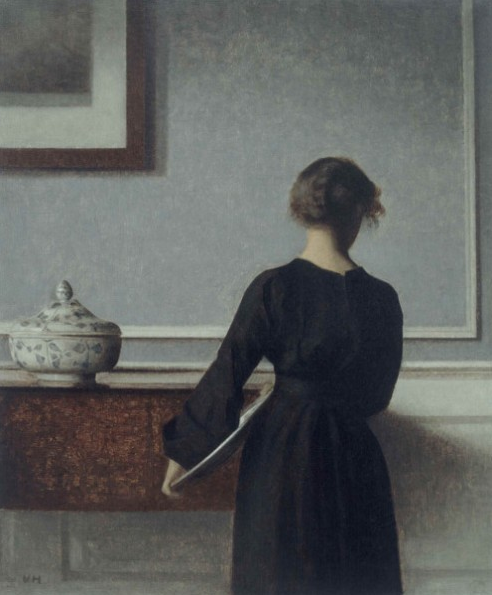Byron’s Decoupage Screen: Reflecting on Celebrity, High Art and Low Culture
Decoupage Screen, Front and Reverse
'What is the end of fame? 'tis but to fill
A certain portion of uncertain paper:
Some liken it to climbing up a hill,
Whose summit, like all hills, is lost in vapour;
For this men write, speak, preach, and heroes kill,
And bards burn what they call their "midnight taper,"
To have, when the original is dust,
A name, a wretched picture, and worse bust.’
Lord Byron, ‘Don Juan’
At a recent visit to the National Portrait Gallery in London, I came across a large folding decoupage screen once owned by Lord Byron.
Decoupage is the art of decorating an object by gluing onto it coloured paper cut-outs from prints or magazines; and then finishing it with a special paint or varnish. Practiced by craftsmen in Italy and France during the eighteenth century, decoupage had become a fashionable hobby by Byron’s time.
This six-foot high, four-panelled screen was created around 1814 by Henry Angelo, Byron’s fencing coach. It could have been used to block out drafts or afford some privacy. Or perhaps it was simply intended for the poet’s amusement.
The screen is covered on one side with notable characters from English theatrical history: portraits of Shakespeare, Sarah Siddons and Edmund Kean; scenes from plays and representations of monuments.
On the other side we find bare-knuckle boxers in action poses – long forgotten figures like Jack Broughton and James Figg; Tom Cribb and Tom Molineaux, the formerly enslaved American fighter. These pictures are surrounded by biographies and accounts of bouts cut from the pages of Pierce Egan’s Boxiana or Sketches of Ancient and Modern Pugilism.
'The best of prophets of the future is the past.'
Lord Byron, Journal 1821
It’s a rather beautiful object in its own right. Busy, bustling, bursting with life. An early nineteenth century version of Pop Art; a scrap-book of contemporary enthusiasms. It’s also a fascinating historical document. It demonstrates that the gifted poet did not just have his head in the clouds. He had a passion for sport and the dramatic arts; for popular culture and celebrity. He was a fan.
'But words are things, and a small drop of ink,
Falling, like dew, upon a thought produces
That which makes thousands, perhaps millions think.'
Lord Byron, ‘Don Juan’
Detail of painting: George Gordon Byron, 6th Baron Byron, in Albanian costume, painted by Thomas Phillips in 1813
We think of celebrity as a phenomenon of the modern era. But the public have been obsessing about famous people for centuries: athletes were lauded in archaic Greek poetry; actors kept the company of political leaders in Pericles’ Athens; gladiators were feted in ancient Rome; emperors had their profiles stamped on coins that travelled to every corner of their domain.
The cult of celebrity runs deep. We imagine we know these special individuals, that we have insight into their thoughts and feelings. We admire their looks and talents; their taste and wit. We aspire to their glamorous lifestyle. We love and envy them.
The phenomenon has, of course, been magnified by successive revolutions in media: from the printing press to radio and cinema; from television to social networks. In Byron’s time awareness of famous people was circulated through the booming platforms of periodicals and prints. Each innovation fuels the public’s appetite to know a little more, to get a little closer.
'Oh, talk not to me of a name great in story;
The days of our youth are the days of our glory;
And the myrtle and ivy of sweet two-and-twenty
Are worth all your laurels, though ever so plenty.’
Lord Byron, Stanzas Written on the Road Between Florence and Pisa
In the world of advertising, celebrities have long been recognised as vehicles for conferring recognition and positive associations. Although consumers know that money has changed hands, there’s still a sense that their hero has endorsed this brand; that they genuinely like and use it. A form of cognitive dissonance, I suppose.
I confess that when I worked in the industry I tended to avoid celebrity campaigns. For me they entailed borrowed interest, taking a conceptual short-cut. And of course they often came at a high price and with reputational risk. But there’s no denying their effectiveness when brand and spokesperson act in synergy. People adore celebrity.
'All who joy would win must share it. Happiness was born a Twin.'
Lord Byron, ‘Don Juan'
Detail from Screen
I was particularly taken with the fact that Byron was a fan of both high art and low culture: theatre and boxing. As an adolescent I was concerned that my admiration of Homer and Handel; Goya and Graham Greene might be undermined by my devotion to sixties soul music and the Likely Lads. But then – prompted by Melvyn Bragg and the South Bank Show – I came to appreciate that different moods have different cultural modes; that any individual has multiple facets to their personality.
It’s only human to seek out both the spiritual and the everyday, the sacred and the profane. We should just follow our passions.
'There are four questions of value in life, Don Octavio. What is sacred? Of what is the spirit made? What is worth living for and what is worth dying for? The answer to each is the same. Only love.'
Lord Byron, ‘Don Juan’
'Who killed Davey Moore?
Why an' what's the reason for?
"Not us", said the angry crowd
Whose screams filled the arena loud.
"It's too bad he died that night,
But we just like to see a fight
We didn't mean for him to meet his death,
We just meant to see some sweat.
There ain't nothing wrong in that.
It wasn't us that made him fall.
No, you can't blame us at all.”'
Bob Dylan, 'Who Killed Davey Moore?'
No. 466




